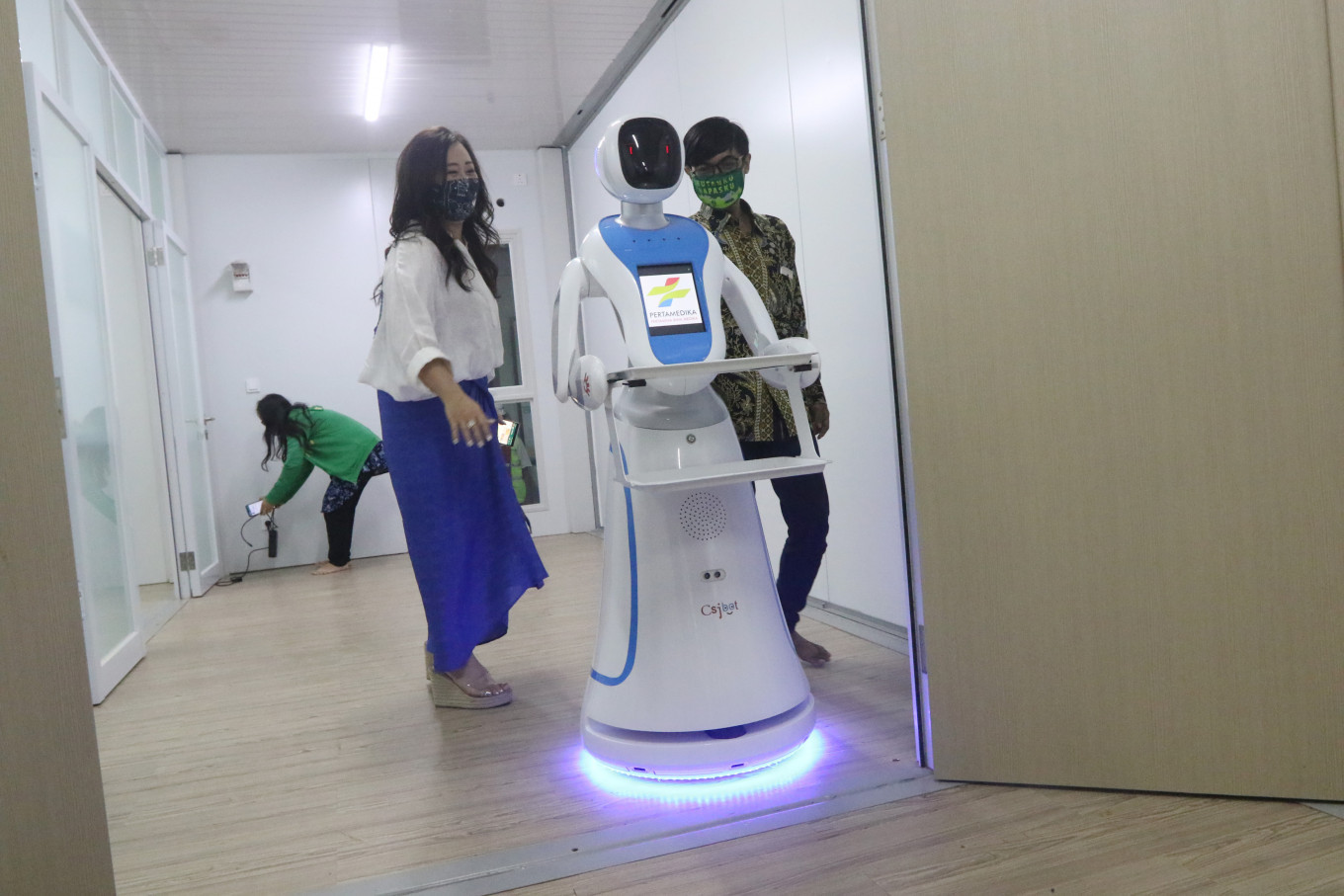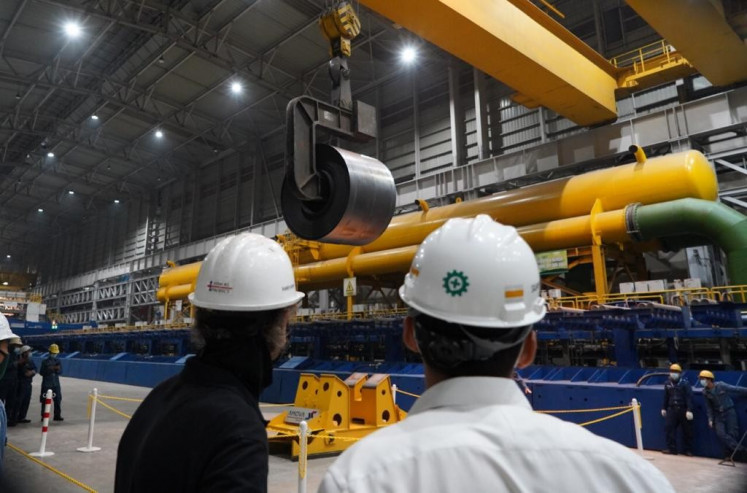Popular Reads
Top Results
Can't find what you're looking for?
View all search resultsPopular Reads
Top Results
Can't find what you're looking for?
View all search resultsOur health system's capacity vs demand from large-scale social distancing
But do we have a health system that has the capacity to anticipate increasing demand as a result of the government’s large-scale distancing policy?
Change text size
Gift Premium Articles
to Anyone
A
s of Monday, here is President Joko "Jokowi" Widodo's instruction on COVID-19: “I order a large-scale social distancing policy [and] physical distancing to be enforced in stricter, more disciplined and more effective ways.”
The press release by COVID-19 fast-response chief Doni Monardo says: “[…] The concluding step taken by the President […] is in the form of large-scale social distancing."
A more detailed definition is in Government Regulation No. 21/2020, which says that large-scale social distancing includes school and business closures, limiting religious activities and/or limiting activities in public spaces. I would also interpret, also from the regulation, that shops and activities for health services, food and basic necessities would remain open.
At least now the government has come up with some policies to contain COVID-19 and to save lives — albeit too late. But do we have a health system that has the capacity to anticipate increasing demand as a result of the government’s large-scale distancing policy?
I've done back-of-the-envelope calculations based on some simple parameters’ values. I rely on various government data as of April 6, as well as academic reports and credible press reports.
Back to the drawing board: It’s (just) a moderate intervention policy
Let’s try to make sense of the government’s policy. The first immediate problem is that we do not have the government’s model on the estimated number of infections and fatalities. On April 2, the government presented a National Intelligence Agency (BIN) model on COVID-19 cases. The fact that the government is relying on the intelligence agency to predict COVID19 cases and, presumably, design the policy based on it, is deeply troubling. So far, the epidemiology basis of the model is far from clear.
So, let us just use a model that I happened to know from Ariawan et al. (2020) from the University of Indonesia’s School of Public Health instead. This model actually has been presented before the COVID-19 fast response team as well as the National Development Planning Agency (Bappenas) — there is no reason for the government to say that we do not have a model because of lack of data or the government is not informed by our own epidemiologists.
Based on my reading on Government Regulation No. 21/2020, large-scale social distancing meets the definition of medium-scale intervention in this UI-Bappenas model. The current large-scale social distancing policy also seems to have many similarities to the Dutch government’s approach, even though the capacity of the Dutch healthcare system is, obviously, in a different league than ours.
It does also mean that, eventually, there would be around 1.2 million people who need to be sent to hospitals.
If it is true that large-scale social distancing is in line with the moderate-intervention scenario, it may potentially delay the peak of daily hospitalization cases by about 20 days. With staggering hospital admissions, we also do not need to provide 1.2 million beds and supporting facilities and medical staff at once. But at least, we need to be able to anticipate the peak of 105,000 daily COVID-19 hospital admissions. Also bear in mind, this model assumes that it takes 14 days for a hospitalized person to recover and seven days for those who do not manage to survive, which is probably an optimistic estimation for the length of a COVID-19 treatment.
So, we now have a rough idea of COVID-19’s demand on the health system, based on the moderate intervention scenario of large-scale social distancing. The next logical step is to assess our supply capacity to deal with this increasing demand.
Back-of-the-envelope calculation: Do we have enough hospital beds?
Under the existing capacity, adopting large-scale social distancing would delay the surge of hospitalized COVID-19 cases but still see about 25 days when the number of hospitalized patients exceeds 50 percent of total beds in major type A and B hospitals. In other words, the pressure on the existing hospital system is still too heavy. To illustrate the problem, at the peak, we need 105,000 beds, but the total number of beds in type A and B hospitals is just 110,000!
Just how many beds do we need to prepare for a surging number of COVID-19 cases? Here is a back-of-the-envelope calculation. Let’s suppose that only major hospitals (type A and B) have the capacity to deal with COVID-19 cases. These hospitals have 110,000 beds. But we know that some of those beds are already occupied by non-COVID-19 patients. If the occupancy rate is 50 percent, that is only half of the total beds in type A and B hospitals are available, it means that we need to set up at least 45,000 beds quickly.
But what is our actual hospital bed occupancy rate? Let’s use the national bed occupancy rate of 77 percent, based on a state-owned (PT Sarana Multi Infrastruktur) report. By that, the number of available beds that could be allocated for COVID-19 cases is 25,000 — that is 23 percent of 110,000 beds. Ergo, to absorb an additional 105,000 COVID-19 cases at the peak, we need to provide at least an additional 80,000 hospital beds! A tall order, indeed.
Java generally has more beds but also a higher bed occupancy ratio and — this is crucial —also a higher number of COVID-19 cases at the moment.
But here is another catch: COVID-19 cases don’t only need regular hospital beds but also intensive care units (ICU) to treat severe cases. If we assume that 14 percent of hospitalized cases need intensive care (as suggested in the Ariawan et al. model), we need at least 14,700 ICU beds at the peak, which is 14 percent of 105,000 hospitalized cases. Let us call this a low-case scenario.
If we take a more conservative rate and follow the Imperial College’s model, “30 percent of those that are hospitalized will require critical care [invasive mechanical ventilation or ECMO]”. With this rate, the demand for ICU beds is as high as 31,500 units — and let’s call that a high-case scenario.
How many ICU beds do we have? Data from the Healthcare and Social Security Agency’s (BPJS Kesehatan) Aplicares shows that, nationally, there are around 3,300 ICU beds. In other words, in a low-case scenario, we’re short of 11,400 ICU beds — 14,700 needed minus 3,300 available. But in a high-case scenario, as we need 31,500 ICU beds, we are short 28,200 beds.
What if we mobilize all intensive care units (ICU, ICCU, NICU, PICU and HCU)? In total, we have around 8000 beds — still short by 6,700 units in the low-case scenario and 23,500 in the high-case scenario.
As in hospital beds, these numbers assume that all ICU beds are available for COVID-19 cases. If taking into account the bed occupancy rate of 77 percent, which is very likely too low for ICU, the number of available ICU beds is just 1,850. In the low-case scenario, we are short by 12,850 ICU beds and 29,650 beds in the high-case scenario. Very concerning, indeed.
The spatial distribution of ICU beds is concentrated in Java, North Sumatra and South Sulawesi. The current epicenters of COVID-19, Jakarta and West Java, are at top of the list. If the outbreak spills out of Java, we are in deep trouble.
And the ventilators?
The other medical equipment crucial for COVID-19 cases is the ventilator; so crucial that many countries are now mobilizing all of their resources to secure this vital equipment and some governments have directly ordered their industries to realign their production facilities for ventilators.
Preliminary data from the Health Ministry, subject to further verification, shows that as of March 22, Indonesia has 8,400 ventilators in state hospitals. This number is not too far from what the health minister claimed before the House of Representatives on April 2.
Assuming that all who need intensive care also need ventilators, we need at least 6,300 more ventilators — that is 14,700 intensive care cases minus 8,400 available ventilators — in the low-case scenario. In a high-case scenario, we are short by 23,100 ventilators. But again, as in the availability of beds, some of the ventilators have already been used by non-COVID-19 patients. If we assume a similar occupancy rate with that of hospital beds, 77 percent, it means that the number of available ventilators is just 1,900 — not 8,400. We are short of 12,800 ventilators in a low-case scenario and 29,600 in a high-case scenario!
Recap
Let us recap the numbers: We probably need approximately 80,000 more hospital beds, of which 12,850 should be ICU beds in a low-case scenario and 29,650 units in a high-case scenario. For the ventilators, we need an additional 6,300 in the first scenario or 23,100 in the latter. I do not know how much protective gear is needed to treat 1.3 million COVID-19 cases, but I would imagine it would be very substantial.
How much will it cost? I do not have any idea of how much building hospitals and ICU beds as soon as possible will cost. But the cost of a ventilator can be between US$18,000 and $30,000. Just multiply the numbers with the number of ventilators needed above.
Besides upgrading the health system’s capacity, there is also a direct cost of treating COVID-19 patients. I do not know the specific cost of treating one COVID-19 case. But to illustrate, the cost of hospitalizing a simple pneumonia and severe whooping cough case in a third-class room of a type A government hospital Rp 12.27 million ($782.90). For a severe case that needs long-term mechanical ventilation without a tracheostomy, the cost is Rp 92 million. Think about this number while knowing that the predicted accumulative number of cases under large-scale social distancing policy is as high as 1.2 million COVID-19 hospitalized cases.
Do we have the money? The Finance Ministry has allocated Rp 75 trillion for upgrading the health system’s capacity and this significantly reduces the financial constraints in dealing with surging COVID-19 cases. The problem is: I do not see a good plan from the Health Ministry to disburse the money effectively.
Last, I have just shown you my (back-of-the-envelope) numbers. I do hope that the government or anyone who has better knowledge on the matter also shows their numbers, so that, hopefully, we can have more thorough evidence-based policies to save lives.
***
Assistant professor in economics and modern Southeast Asia, Leiden Institute for Area Studies, Leiden University
The original article was published in CSIS commentaries.










